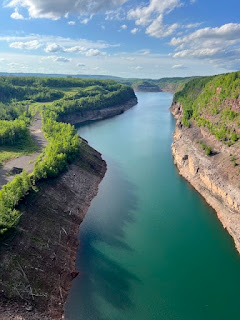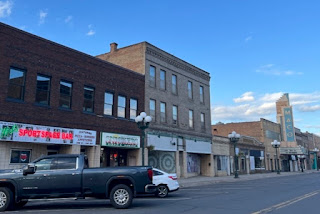I’m not a competitive athlete, but over the past 3 years I’ve been doing a lot of exercise. This is relatively new for me. I’ve always been active but I scaled up the exercise when I went from middle-aged to old. (Whatever the dictionary may say, 55+ is different from 50- for most of us.)
Yesterday I played at being a competitive athlete. It was the first official race I’ve competed in since I was a member of short-live swim team [1]. I’d been in timed events previously, but they were either not official races or I was keeping a slow child company. This time it was the real thing — a regional mountain biking race known as the Chequamagon Fat Tire Festival.
Since then I’ve been ruminating about the race more than I expected. Enough rumination that I’m compelled to write it out.
There are two distances at this race, the 40 mile and the 16 mile. Neither is technically demanding; the 16 has a slightly higher technical and single track percentage. Although the trails aren’t technical it would be hard to do the race without a fat tire; the often steep trails are grassy, sandy and usually muddy. There are minimal prizes but the race still attracts some amazing regional athletes. Even the 16 has some elite riders who for various reasons didn’t want to do the 40 or couldn’t get a slot.
I started near the front of wave (gate) 6 for the 16 mile race, the last and largest wave. I finished at 1:29:46, 42 of 85 in the 55-59 men’s group [3]. That means next year I’d start in wave 5.
I did some things right. I switched my obsolete 26” [2] Cannondale Team Scalpel from 2.1” dry surface XC tires to 2.2” climbing tires. I went easy on my CrossFit class the day before the ride. I’d done a good amount of trail riding with skilled people so I was much better on downhills and shifting than most of my cohort. I carried and used “goo”, small pouches of high glucose paste. My bike was in good mechanical shape. Some recent straight leg raise work seemed to help my arthritic knees. [4]
I make some mistakes. I should have skipped CrossFit for a week before the ride — my inner quads started out sore and sluggish and improved slowly. I wore a long sleeved undershirt because the start was cold and drizzly — I had to stop and remove it. I should have brought a waterproof heavy warmup jacket and put it in the “checked post-race” bag just before the bike-ready deadline [6]. I forgot to take the goo 5 minutes before start — I was amazed how well it worked during the race. I didn’t drink as much as I thought I had, that would have been a problem in a longer race. I carried a hydration pack but for this distance I might have been better with water bottles. I didn’t have a race plan or a timer/speedometer so it was hard to adjust my effort. I didn’t realize there’d be no AT&T coverage; I could have left my phone behind [7]. I also didn’t train for the race, but that was by choice [5].
When I was done I felt like I’d had a big CrossFit workout — the kind of thing I do every 1-2 weeks. I’ll clearly never be a contender — I don’t have the genetics. It was fun though.
Were I to repeat the 16 next year, starting in wave 5 with fewer mistakes, some race planning, and a watch (or speedometer), I think I could get to wave 4 (3% faster). To get to wave 3 (13% faster) I’d definitely need to train. I suspect wave 3 would be my limit.
I’m more likely to try the 40 — if my knees allowed. I would want to train though.
This business of competing but not contending isn’t so different from everyday life …
- fn -
[1] At a High School that didn’t have swim team practices. It did not go well.
[2] Obsolete because after decades of using 26” wheels inherited from trick bikes of the 70s manufacturers realized that bigger wheels were faster. The transition happened around 2010; new materials and designs enabled stronger wheels and bigger profit margins. Thanks to information asymmetry in 2014 I purchased a lovely but obsolete 2010 racing machine that has been both educational and costly. On this particular race however my bike wasn’t in any way a limiting factor; I didn’t spin out on climbs.
The 29” transition was followed by a 27.5” option for shorter riders and the fat bike option. Lots of real tech improvement has created an explosion of good bikes. Which means a crash is sure to come…
[3] I was 376/702 for all men, 445/946 overall. Pretty much the median rider — at my level there’s not as much drop off with age as one might think. The winning time as 51:53 — an average of 18 mph for 16 miles. The winner of the 40 mile race averaged 19.2 mph for 40 miles. Different course profiles, but rain and timing meant the 40 had even more mud …
[4] Inherited slow-mo knee-hand-foot thing. I bought some cheap ankle weights and I do straight leg raises while sitting (work) and driving (commute, nobody around, cruise control, no obvious problems when I test braking response.) The only way to do something as boring as weighted leg raise.
[5] I didn’t want to give up my CrossFit (CFSP, yeah) time, and my mountain bike time is focused on being with #2 son who is even less athletic than I am.
[6] The post-race bag was a nice feature, it was transported to the finish were there were showers with bath gel post-race! Bag should hold a warmup jacket, a light but big backpack for carrying things (so don’t need to keep bag), a towel and wash cloth, shoes, clothing, etc.
[7] So weird to be in an AT&T coverage hole. I missed meeting up with a friend because we didn’t set up an old-school rendezvous point.



















